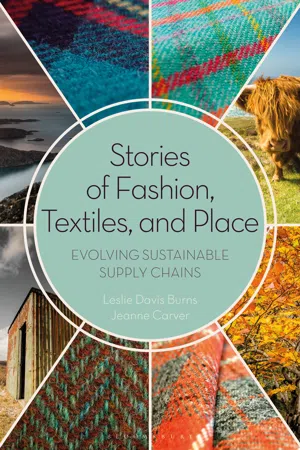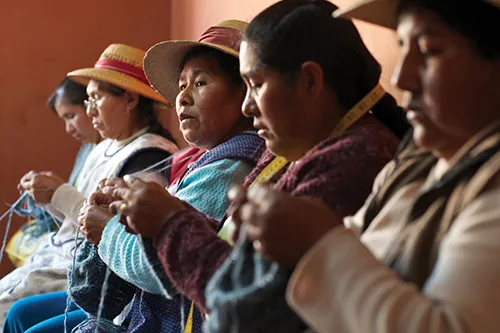![]()
1
Sustainable Supply Chains in the Global Fashion Industry
Creating Value and Reflecting Values
Look around at all the products made from textiles—apparel, accessories, carpets, blankets, pillows, tablecloths, upholstery, and window coverings, just to name a few. These products are part of our everyday lives—warming us, cooling us, protecting us, assisting us, and giving us joy and comfort. These are the products of the global fashion industry, the businesses throughout the world that are involved in all aspects of the design, creation, manufacturing, marketing, and retailing of these products. These businesses are part of integrated supply chains, the networks and processes that take the product from raw materials to finished products to the end-use consumers, and in some cases back again to raw materials or renewed products.
In the global fashion industry, the supply chains include suppliers of textiles (raw materials); findings, trims, and notions; product manufacturers; and distributors and retailers of fashion products: apparel, accessories, home fashions/textiles, and textiles used in commercial settings such as hotels and offices (Burns and Mullet 2020).
1. Textile suppliers. The term textile is used to describe any fabric (e.g., woven, knitted, or nonwoven material) made from natural protein fibers (e.g., wool, cashmere, silk), natural cellulose fibers (e.g., cotton, flax, henequén), and/or manufactured fibers (e.g., nylon, polyester, rayon). Textiles suppliers include companies and textile mills involved with fiber processing, yarn spinning, fabric production, and fabric finishing. They are often referred to as the “raw materials” of fashion products.
2. Findings, trims, and notions suppliers. Findings, trims, and notions are the components, other than materials, needed to manufacture fashion products, including thread, fasteners, buttons, zippers, elastic, hemming tape, cords, and lace.
3. Product manufacturers. Product manufacturers (often referred to as cut, make, and trim suppliers) convert textiles, findings, trims, and notions into finished products. Product manufacturers supply fashion brands with merchandise they sell to the ultimate consumer.
4. Distributors and retailers. Distributors and retailers of finished products transport and deliver merchandise to the ultimate consumer. Retail operations include brick-and-mortar, e-commerce, omnichannel, and direct sales.
5. Re-commerce, rental, upcycling, and recycling. In a circular supply chain, textile resources are kept in use for as long as possible as renewed raw materials, components, and finished products.
In general, the supply chains within the global fashion industry are highly fragmented; that is, different companies operate at each of the stages. Companies involved at the raw material stage sell to textile mills that sell to manufacturers, who may have contracts with fashion brands. In some cases, a vertically integrated company may own and operate businesses across stages. Supply chains also evolve over time as new technologies, strategies, suppliers, and buyers create new opportunities and partnerships.
At each stage of the fashion supply chain, value is added. In this case value refers to the monetary worth of what is created. According to this concept, materials are worth more than fibers, finished products are worth more than materials, retailers provide a service that adds worth to the product for the consumer, and textiles have worth beyond their first use. In fact, the term value chain is often used to describe this approach to the fashion supply chain.
The monetary value-added and growth-oriented approach to the global fashion supply chains has resulted in one of the largest and most diverse industries in the world with estimates that employment is more than 300 million worldwide (Ellen MacArthur Foundation 2017). Fashion products are manufactured for both domestic and international markets and sold to consumers through a variety of retail venues, contributing to local, regional, and national economies. Fashion products are sold at local markets, through small retailers, and through large multinational chains. Globalization has led to vast trade among countries that specialize in one or more stages of fashion supply chains. In fact, the World Trade Organization (2020) reported that in 2017 over 160 economies were involved in textile and clothing trade.
But what happens to the concept of value when a consumer purchases a new cotton knit T-shirt for only US$5 through a multinational chain retailer? The monetary value associated with the cotton, the knit fabric, and the labor required to sew the T-shirt would be even less. In this context, the consumer has become removed from the resources, processes, and people necessary to create the T-shirt, not knowing how or by whom the cotton was grown and harvested, the knit fabric produced, or the T-shirt sewn. And with such little value associated with the T-shirt, after wearing it only a few times, the consumer thinks nothing of simply throwing it away and purchasing another to replace it. This linear fashion system (make, use, dispose) of inexpensive fashions has led to massive overconsumption and textile waste, depleting both natural and human resources and resulting in environmental and social systems that are not only unsustainable but are inherently damaging to societies and natural environments.
The challenges facing the global fashion industry are well documented. Comprehensive reports including those published by The Business of Fashion and McKinsey and Co. (2021), Ellen MacArthur Foundation (2017), Global Fashion Agenda (2019), and the Waste and Resources Action Programme (WRAP 2017) outline the environmental and social issues across the supply chains of the global fashion industry. For example, synthetic and hazardous chemicals are used throughout the manufacturing processes for textiles, components, apparel, and home fashions. Many factory workers are not being paid a living wage while they continue to work in unsafe and unhealthy conditions. Consumers purchase large quantities of inexpensive low-quality apparel, accessories, and home fashions with the expectation of wearing/using them a limited time and then throwing them away. These practices contribute to the large amounts of textile waste in our landfills (Ellen MacArthur Foundation 2017).
In moving forward, fundamental approaches to supply chains in the global fashion industry must change. Sustainability plans with goals and metrics have been set by international organizations (e.g., United Nations Sustainable Development Goals, 2020), national governments and agencies (e.g., UK Sustainable Development Goals 2019), fashion industry–specific organizations (e.g., Global Fashion Agenda’s 2020 Commitment, 2020), and companies themselves (e.g., Eileen Fisher’s Horizon 2030, 2020). These plans outline strategies for companies to further their sustainability efforts and for consumers to participate through their purchasing behavior. The strategies advance practices whereby textiles and fashion products are considered valued resources, the true costs of fashion products are reflected in their prices, and consumers are educated about the environmental and social impacts of their purchase decisions.
These sustainability plans challenge companies within the global fashion industry to create supply chains that reflect values in addition to monetary worth. Value, in this case, refers to the importance of qualities, such as environmental stewardship, human empowerment, or advancing cultural traditions, that are incorporated into companies’ business strategies, practices, and operations. These values are evident not only in how they do business but also in the products they create, manufacture, and sell. In other words, companies can both create value and reflect values through sustainable supply chains. Companies within the global fashion industry use a number of interconnected strategies to create sustainable supply chains that both add value and reflect values, often with a particular focus. For example, some companies focus on responsible management of natural resources, others on eradicating human trafficking, others on providing educational opportunities for individuals in communities they serve. But all strive to add value and reflect values. Scholars in design, marketing, supply chain management, and production have written about these interconnected strategies for creating sustainable supply chains in fashion (see Recommended Reading at the end of the book for an annotated listing of relevant books). These books provide overviews, frameworks, and in-depth analyses of strategies. The purpose of the current book is to explore the value of place in creating sustainable supply chains through narratives of five companies.
The Value of Place
The companies selected for inclusion in the current book share a value of and connection to place. The concept of place for these companies is more than the location of their headquarters, where they have operations, where they source materials or production, or where they sell products. These companies were founded because of place and are committed to advancing cultural traditions of a particular place. They value, honor, and are all deeply rooted in the geography, culture, and people of a specific location, and their success is attributable to their connection to that place. These companies include:
Imperial Stock Ranch and Shaniko Wool Company—Oregon, USA At the forefront of rebuilding connections, traditional skills and strengthening supply chain partners, Imperial Stock Ranch and Shaniko Wool Company offer certified traceable raw materials for sustainable products (Figure 1.1).
Figure 1.1 Traceable wool from Imperial Stock Ranch was used for the sweater of Team USA Opening Ceremony uniforms for the Sochi 2014 Olympic Winter Games. Photo by Pascal Le Segretain/Getty Images.
Angela Damman Yucatán—Yucatán, Mexico In partnership with local artisans, Angela Damman Yucatán advances cultural traditions through the creation of luxury textiles and products using age-old techniques of processing and weaving fibers from native plants, henequén and sansevieria (Figure 1.2).
Figure 1.2 Elevated designs of Angela Damman Yucatán using fibers of native plants. Photo courtesy of Namuh Studio/Angela Damman.
Tonlé—Phenom Penh, Cambodia As a zero-waste fashion brand of products made from textile waste, Tonlé furthers environmental sustainability, inclusivity, and social justice (Figure 1.3).
Figure 1.3 Tonlé exemplifies socially responsible apparel production. Photo courtesy of Tonlé.
Indigenous Designs—Highlands, Peru In partnership with artisan co-ops, Indigenous Designs creates fashions with organic cotton, sustainably raised alpaca, and low-impact dyes while contributing to economic development of communities (Figure 1.4).
Figure 1.4 Indigenous Designs partners with artisan co-ops to create high-quality knitted goods. Photo courtesy of Indigenous Designs.
Harris Tweed®—Outer Hebrides, Scotland, UK With a rich tradition of high-quality hand-woven wool fabrics, Harris Tweed reflects and furthers the unique interconnections among the land, community, and cloth (Figure 1.5).
Figure 1.5 Harris Tweed fabric is hand woven at the homes of weavers in the Outer Hebrides. Photo by wanderluster/Getty Images.
Why is the value of place so important? From a historical perspective, until the 1700s textile production was a hand process using the fibers available within a particular geographic region, for example, cotton, wool, henequén, silk, and flax. Trade among regions increased the availability of these fibers and associated textiles made from the fibers. The First Industrial Revolution and subsequent technological advancements in manufactured fibers added to the fact that fibers and textiles were no longer “place-bound.” Fashion companies created and consumers could acquire textiles and products made from textiles with little or no connection to where, how, or by whom the products were made. This resulted in a disconnect between consumers and the products they use on a daily basis, a loss of understanding and appreciation in the skills and resources necessary to create these products, and an associated disregard for the human and natural resources necessary for the products’ creation. Therefore, renewing a value on place reconnects the company and the consumer with the people, geography, and culture of a particular location. What emerges from renewing the value of place are the locally available fibers, traditional textile designs, skills of artisans, and communities associated with creating textiles and apparel. The value of place is reflected throughout these companies’ supply chains in the environmental sustainability of the fibers and textiles they create and use, in the cultural traditions associated with creating materials, in their production processes, in their community engagement, and in their communication and connection with consumers. These are the characteristics of place that the companies highlighted in the current book aspire to revive, enhance, and promote in new ways.
This introductory chapter provides context, background, and definitions that will be relevant to the narratives of the companies discussed. The ...





